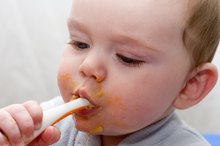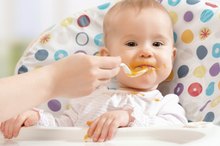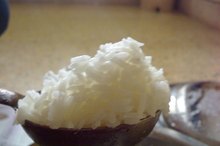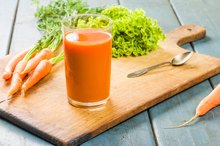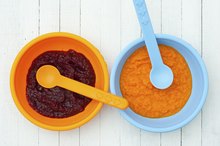Diaper rash is a painful condition for your baby and can cause fussiness and discomfort. MedlinePlus.com reports that it is common for your baby to develop a diaper rash if she is not kept clean and dry 13. As you begin to introduce solid foods to your baby, some of the new foods may cause your baby to develop a diaper rash as well. New foods can cause your baby's stool to change, which can lead to a rash. Knowing the most common food causes will help you modify your little one's diet.
Tomatoes
Tomatoes are considered an acidic food, which increases the likelihood that your baby will develop a diaper rash. If your baby is eating solid foods, he may develop a diaper rash if he eats a large amount of tomatoes or tomato-based foods. If you notice a diaper rash, eliminate tomato products, including ketchup, from his diet to see if the rash heals and does not return.
Oranges
A Baby's Allergies to Sweet Potatoes
Learn More
Oranges are another acidic food that may cause your baby to develop a painful diaper rash. If your baby drinks orange juice, pureed baby foods with oranges, or chopped orange segments, these foods may be the cause:
- of her diaper rash
- Wayne B
Jonas
Jennifer Jacobs note in their book
"Healing with Homeopathy: The Complete Guide." Eliminating orange juice and foods with oranges can help your baby's stool return to normal so her rash can begin to heal 2.
Berries
Strawberries, raspberries, blueberries and blackberries are acidic foods that can lead to a diaper rash. The acid in these foods changes the composition of your baby's stool so that when he eliminates the stool causes his bottom to break out in a rash. Berries often cause a diaper rash when they are first introduced into your baby's diet, but can cause a rash even if your baby has eaten them several times. Make sure to change your baby's diaper as soon as he soils it to reduce the chances that he will develop a rash. Restricting his intake of berries may also help. The University of California at San Francisco's Benioff Children's Hospital reports that berries should not be introduced into your baby's diet until at least 9 months of age 4.
- Strawberries, raspberries, blueberries and blackberries are acidic foods that can lead to a diaper rash.
- The acid in these foods changes the composition of your baby's stool so that when he eliminates the stool causes his bottom to break out in a rash.
Related Articles
References
- MedlinePlus.com: Diaper Rash
- Healing with Homeopathy: The Complete Guide; Wayne B. Jonas and Jennifer Jacobs
- AskDrSears.com: Diaper Rash
- UCSF Benioff Children's Hospital: FAQ: Introducing Your Baby To Solid Foods
- Jeffery LA, Karim S. Botulism. [Updated 2019 Nov 30]. In: StatPearls [Internet]. Treasure Island (FL): StatPearls Publishing; 2019 Jan-.
- Koplin JJ, Allen KJ, Gurrin LC, et al. The impact of family history of allergy on risk of food allergy: a population-based study of infants. Int J Environ Res Public Health. 2013;10(11):5364–5377. Published 2013 Oct 25. doi:10.3390/ijerph10115364
- American Academy of Pediatrics. Infant Food and Feeding. AAP.org. Published 2020.
- American Academy of Pediatrics. Committee on Nutrition. Hypoallergenic infant formulas. Pediatrics. 2000;106(2 Pt 1):346-9. doi:10.1542/peds.106.2.346
- Ferraro V, Zanconato S, Carraro S. Timing of Food Introduction and the Risk of Food Allergy. Nutrients. 2019;11(5):1131. Published 2019 May 21. doi:10.3390/nu11051131
- Cabana MD. The Role of Hydrolyzed Formula in Allergy Prevention. Ann Nutr Metab. 2017;70 Suppl 2:38-45. doi:10.1159/000460269
- National Collaborating Centre for Women's and Children's Health (UK). Identification and management of trigger factors. Atopic Eczema in Children: Management of Atopic Eczema in Children from Birth up to the Age of 12 Years. Published December 2007.
- Abeshu MA, Lelisa A, Geleta B. Complementary Feeding: Review of Recommendations, Feeding Practices, and Adequacy of Homemade Complementary Food Preparations in Developing Countries - Lessons from Ethiopia. Front Nutr. 2016;3:41. Published 2016 Oct 17. doi:10.3389/fnut.2016.00041
- Hagan JF, Shaw JS, Duncan PM. Bright Futures: Guidelines for Health Supervision of Infants, Children, and Adolescents. Elk Grove Village, IL: Bright Futures/American Academy of Pediatrics; 2017.
- NIAID-Sponsored Expert Panel, Boyce JA, Assa'ad A, et al. Guidelines for the diagnosis and management of food allergy in the United States: report of the NIAID-sponsored expert panel. J Allergy Clin Immunol. 2010;126(6 Suppl):S1–S58. doi:10.1016/j.jaci.2010.10.007
- Abrams EM, Becker AB. Food introduction and allergy prevention in infants. CMAJ. 2015;187(17):1297–1301. doi:10.1503/cmaj.150364
- Koo YC, Chang JS, Chen YC. Food claims and nutrition facts of commercial infant foods. PLoS One. 2018;13(2):e0191982. Published 2018 Feb 28. doi:10.1371/journal.pone.0191982
- Van den boom S, Kimber AC, Morgan JB. Nutritional composition of home-prepared baby meals in Madrid. Comparison with commercial products in Spain and home-made meals in England. Acta Paediatr. 1997;86(1):57-62. doi:10.1111/j.1651-2227.1997.tb08833.x
- Caffarelli C, Di Mauro D, Mastrorilli C, Bottau P, Cipriani F, Ricci G. Solid Food Introduction and the Development of Food Allergies. Nutrients. 2018;10(11):1790. Published 2018 Nov 17. doi:10.3390/nu10111790
- Kusari A, Han A, Eichenfield L. Recent advances in understanding and preventing peanut and tree nut hypersensitivity. F1000Res. 2018;7:F1000 Faculty Rev-1716. Published 2018 Oct 30. doi:10.12688/f1000research.14450.1
- Daniels L, Heath AL, Williams SM, et al. Baby-Led Introduction to SolidS (BLISS) study: a randomised controlled trial of a baby-led approach to complementary feeding. BMC Pediatr. 2015;15:179. Published 2015 Nov 12. doi:10.1186/s12887-015-0491-8
- Leung AK, Sauve RS. Whole cow's milk in infancy. Paediatr Child Health. 2003;8(7):419–421. doi:10.1093/pch/8.7.419
- Jeffery LA, Karim S. Botulism. [Updated 2019 Nov 30]. In: StatPearls [Internet]. Treasure Island (FL): StatPearls Publishing; 2019 Jan-.
- Nichols BG, Visotcky A, Aberger M, et al. Pediatric exposure to choking hazards is associated with parental knowledge of choking hazards. International Journal of Pediatric Otorhinolaryngology. 2012;76(2):169-173. doi:10.1016/j.ijporl.2011.10.018.
- Awadalla N, Pham T, Milanaik R. Chew on This: Not All First Finger Foods Are Created Equal. Clin Pediatr (Phila). 2018;57(8):889-894. doi: 10.1177/0009922817733701
- Chan ES, Abrams EM, Hildebrand KJ, Watson W. Early introduction of foods to prevent food allergy. Allergy Asthma Clin Immunol. 2018;14(Suppl 2):57. Published 2018 Sep 12. doi:10.1186/s13223-018-0286-1
- Nwaru BI, Erkkola M, Ahonen S, et al. Age at the Introduction of Solid Foods During the First Year and Allergic Sensitization at Age 5 Years. Pediatrics. 2009;125(1):50-59. doi:10.1542/peds.2009-0813.
Writer Bio
Sara Ipatenco has taught writing, health and nutrition. She started writing in 2007 and has been published in Teaching Tolerance magazine. Ipatenco holds a bachelor's degree and a master's degree in education, both from the University of Denver.
